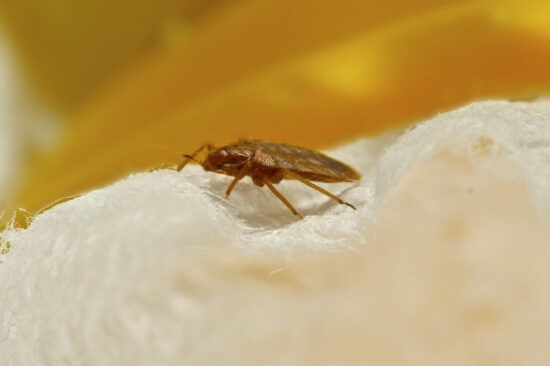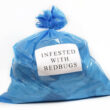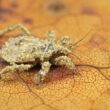Getting rid of bed bugs in your couch can seem intimidating at first, and we understand why. These little critters are hard to track down and notoriously difficult to remove.
But it is possible.
This guide will teach you how to get rid of bed bugs in couches, and also help you understand why they’re lounging around your sofa in the first place!
Table of contents
How Do Bed Bugs End Up In Couches?
Bed bugs are most prevalent in the bedroom. It’s how they got their name, after all!
However, that doesn’t mean that these pests won’t appear elsewhere.
You see, bed bugs are attracted to one thing and one thing only, and that’s you. The insects are parasitic and only feed on blood to survive.
Technically speaking, they can eat the blood of any mammal. However, they much prefer human blood because of our body’s warmth. Plus, we offer all of the nutritional elements these insects need to thrive (lucky us).
Thanks to their nocturnal nature, they only feed at night. Bed bugs feed for only minutes at a time and stay covered by the darkness of night, making them pretty elusive.
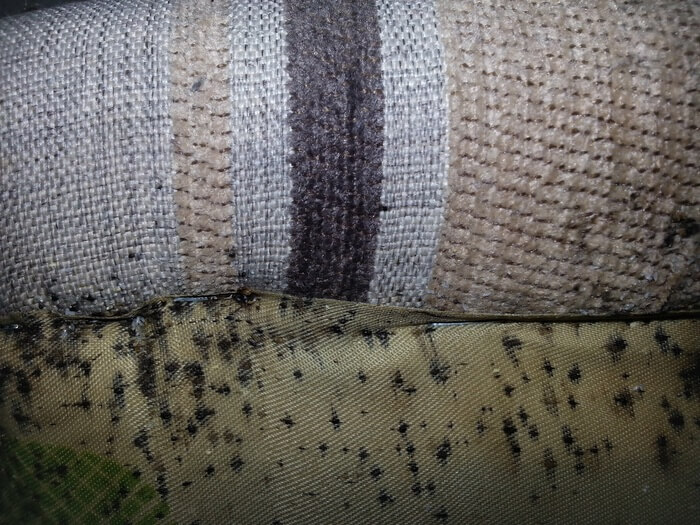
Because most of us are in bed when they start feeding, these insects naturally gravitate to the bedroom. So, why do bed bugs sometimes show up in the couch?
Ultimately, it all comes down to your nighttime habits. Do you like to curl up on the couch every night to watch television? How many times have you fallen asleep doing so?
- Kill bed bugs and bed bug eggs
- Use spray as a spot treatment around bed frames, mattress seams/tufts/folds, and baseboards
- Kills even the toughest bed bugs
- The continuous spray Comfort Wand easily gets into hard-to-reach areas
There’s probably your answer right there!
Everyone’s guilty of falling asleep on the living room couch from time to time. Unfortunately, that habit is what’s attracting bed bugs to your home’s most comfortable piece of furniture.
It’s not the sofa itself that’s drawing them in. Sure, the furniture likely offers plenty of hiding places to keep them sheltered. But at the end of the day, it’s you that they’re after!
If you’re hanging out on the couch regularly, these pests will surely follow.
Quick Tip: If you have a couch that’s in close proximity to your bed (which is especially common in studio apartments), there’s always a possibility that they’ve traveled there from your bed. Bed bugs spread fast, so an infestation on your bed could easily end up on your couch in this situation.
Signs That They’re Living In The Couch
Bed bugs are master escape artists. They have a knack for going unnoticed for weeks. By the time homeowners finally realize that there are bed bugs in the couch, the population is already growing rapidly.
All that said, these pests do leave behind evidence. With a careful eye and some understanding of what you’re looking for, you can easily confirm their presence.
Here are some telltale signs that you’re facing a bed bug infestation in your couch.
Live Bed Bugs
Obviously, the most obvious symptom of bed bugs in the couch is seeing them with your own eyes! While they tend to stay hidden during the day, it’s sometimes possible to spot them. Overcrowding often forces some bugs out of their nest during the day as they search for food.
You can also go looking for them with a few tools. Use a bright flashlight to illuminate crevices and cracks in the couch. Look between cushions and near armrests. If you’re able to, look below the cushions and examine the wooden framing (bed bugs can live in wood after all).
Couches have a lot of hiding places for bed bugs to live. Take some time to do a thorough examination of your sofa to see if you can spot them.
Quick Tip: Be extra careful not to rock the boat too much! The last thing you want to do is flip your sofa around and cause a massive disturbance. Doing so could cause the bed bugs to flee to other areas of your home.
Bed bugs look similar to other pests, but they have a few defining traits. First of all, they’re oval-shaped and about the same size as an apple seed. These bugs are typically dark brown. However, you might see some tinges of red in a freshly fed bug.
The bottom portion is the most prominent. It’s flat and features several accordion-like folds. When the bug feeds, the abdomen expands and plumps up to accommodate the blood.
Shed Exoskeletons
Adult bed bugs do not shed. Once they reach maturity, they stay the same size and only darken with time.
On the other hand, baby bed bugs shed pretty frequently! After hatching, bed bug nymphs go through five stages of development. Between each step, they shed their skin and leave it behind. They do this to make room for a larger body.
Those old skins don’t just dissolve into nothingness. They’re made of a material that’s similar to the keratin in your fingernails. As a result, they’re pretty tough and can hold their shape for years if undisturbed.
During your search, keep an eye out for these old exoskeletons. They look like hollowed-out versions of young bugs. You might even spot some dead bugs in the mix.
Either way, finding shells near your couch is not something you should ignore. It indicates that the bed bugs in your couch are laying eggs, feeding, and maturing.
Eggs
The next sign of trouble you should look for is bed bug eggs.
Eggs are notoriously difficult to spot due to their tiny size. They’re usually only about a millimeter long and resemble a very small piece of rice.
Quick Tip: The overall visibility of eggs largely depends on the color of your couch. If you have a darker-colored sofa, you may have an easier time. The eggs are off-white, making them stand out on contrasting surfaces.
Bed bugs can lay eggs just about anywhere. The casings are sticky, so they can adhere to vertical surfaces or stay stable on flat ones. To make matters worse, female bed bugs lay eggs every day! Healthy bugs may lay upwards of 500 during their lifetime!
The good news is that most deposit eggs in the areas they frequent. That means you may find some in the many voids and cracks in your couch.
Droppings
Notice some black streaks on your couch upholstery? We hate to break it to you, but you could be looking at bed bug feces!
- Kill bed bugs and bed bug eggs
- Use spray as a spot treatment around bed frames, mattress seams/tufts/folds, and baseboards
- Kills even the toughest bed bugs
- The continuous spray Comfort Wand easily gets into hard-to-reach areas
That’s right, bed bugs poop.
The droppings are usually dark brown or black. If smeared, you may notice a slight hint of rusty red.
The feces appear as tiny dots. They’re even smaller than eggs and nymph bed bugs.
The problem, however, comes with how they spread. There’s a good chance that people sitting on your couch inadvertently spread the poop, resulting in that signature streak. Unfortunately, bed bug feces are not easy to clean up.
The poop gets more challenging to remove the longer it sits. While it’s not something anyone wants to think about, finding those stains is a big sign that you need to get rid of some bed bugs in your couch.
Bloodstains
Finally, the last sign of a bed bug infestation is bloodstains. You might see tiny spots of red or reddish-brown. Those spots of blood aren’t from the bed bugs. They’re from you!
Oftentimes, bite wounds will continue to bleed a bit after feeding. Some bugs may also regurgitate the blood as they escape.
You’re more likely to find bloodstains if you have a light-colored couch. They may also appear on throw pillows or blankets.
How To Get Rid Of Bed Bugs In Your Couch
So, you find all the signs of bed bugs. What now?
Getting rid of bed bugs in your couch can be a bit of a challenge. They’re quick spreaders and master evaders.
To effectively remove them, you have to act fast and hit hard!
1. Wash What You Can
Start by washing everything that you can. Remove cushions, cushion covers, blankets, throw pillows, and anything else from your couch that’s removable. Don’t waste time here. Get those items into the washing machine as soon as possible!
Turn the washing machine up to the highest setting possible. Bed bugs are no match for scalding hot water. Generally, these pests will all die off in about 20 minutes in temperatures around 118 degrees Fahrenheit.
Quick Tip: Not sure about water temperatures in your machine? Put the load on a 90-minute cycle to be on the safe side. Even at slightly lower temperatures, bed bugs will die with prolonged heat exposure.
Again, try your best not to tussle things around too much. We know that dealing with bed bugs can be a chaotic situation, but you need to do your part to minimize spread as much as possible.
If you’re unable to fit larger pieces in your washing machine, try going to a laundromat. Those commercial machines are great at penetrating thicker upholstery fabrics.
After your cycles are finished, pop the sofa items into the dryer. Again, use the highest temperature setting possible!
This step is going to act as a failsafe. Chances are, all of the bed bugs die in the washing machine. But it doesn’t hurt to be extra careful, right?
2. Vacuum Thoroughly
As your washing machine is going, put your vacuum cleaner to work. Despite what you might have heard, vacuuming is a vital part of getting rid of bed bugs in your couch.
You can get rid of tons of bugs in one fell swoop. Even if some evade your vacuum’s nozzle, you can usually pick them up later on repeated cleanings.
Use all of the small nozzles and intricate parts your vacuum has to offer. The goal here is to work on every last inch of your sofa! Get into all those nooks and crannies.
Quick Tip: Remember that bed bugs like to hide in discrete voids. Don’t overlook seams, crevices, and cracks. Vacuum it all!
Not only are you getting rid of bed bugs in your couch, but you can also use your machine to pick up shed skin, feces, and eggs.
If you have access to one, we recommend using a vacuum with a HEPA filter. These filters prevent the things you vacuum from becoming airborne. When you’re trying to control the spread of a bloodsucking pest, there’s no better machine than one with a HEPA filter!
That said, you can use any vacuum that has a sealed dust container.
Once you’re done, immediately dispose of the contents in an airtight bag. Don’t just toss the dust in your bin. Vacuuming doesn’t always kill the bugs, so they can easily escape your trash can for another couch invasion.
Put everything in a sealable plastic bag and dispose of it outdoors.
3. Steam
Steam cleaners are a fantastic tool to have in your arsenal. Many professional exterminators utilize steam machines to eradicate bed bugs in couches.
As we mentioned earlier, bed bugs don’t do well with heat. Steamers let you use that fact to your advantage.
Steam cleaners are available to rent at many stores. Alternatively, you can spend a few hundred bucks to get your own. While it seems like a hefty price tag, it’s a wise investment that can help you clean, sanitize, and de-bug your home in the future.
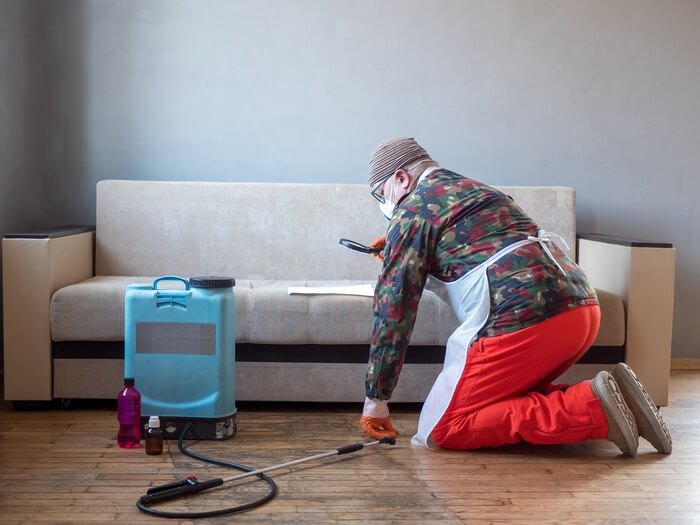
Try to find a machine that can reach steam temperatures of 180 degrees Fahrenheit. At that temperature, the steam will kill bed bugs on contact!
Like your vacuum cleaner, make use of all attachments. Precision nozzles are convenient for getting into tight spots that your vacuum couldn’t reach.
Cover every surface and work methodically to kill as many bugs as possible. Then, follow up with your vacuum to pick up the dead insects. After letting your sofa dry, it should be good to go!
4. Spray Leftover Bed Bugs
Still have some bugs lingering around your couch? After washing, vacuuming, and steaming, turn to an insecticide spray to get the job done.
Sprays are best used for bed bugs that you can see. They aren’t suitable for facing massive infestations, as the spray could cause others to flee. But after you’ve gone through all the other steps, it should be safe to use sprays.
Both chemical-based and all-natural sprays are available. The best choice for you depends on your family’s needs and preferences.
Quick Tip: Chemical sprays do have their risks. Don’t forget to wear a mask and open some windows to ensure that you’re not inhaling the product. Also, keep all pets and kids off the couch as the solution works its magic. Skin contact could cause irritation.
All-natural sprays typically utilize vinegar or essential oils to get rid of bed bugs in the couch. With proper application, they can be just as effective as the chemical stuff!
5. Set Up Some Traps
Last but not least, set up some traps! There are several kinds of bed bug traps out there.
While baited traps do exist, they tend to have less efficiency than the alternatives. Unlike roaches or ants, bed bugs aren’t so easily swayed by bait foods. These pests eat human blood, making food-based traps a swing and a miss in most cases.
Some manufacturers utilize CO2. It’s meant to simulate the exhale of human breathing. While there is some degree of efficiency there, you may be better off using glue traps or interceptors.
Glue traps are pretty self-explanatory. They have a sticky surface that stops these bugs in their tracks! Bed bugs aren’t the strongest crawlers as it is, so glue traps can be quite helpful.
Set some up around the couch at night to catch them in the act.
Interceptors are unique devices that you attach to the legs of your couch and lift it off the ground a bit. The trap contains some talcum powder to dehydrate the bugs and stop them from escaping.
The idea is that you naturally attract the bugs while you sit on the couch. When they try to climb up the legs to get to you, they fall into the interceptor to their demise!
Try utilizing several different kinds of traps to maximize your chances of success.
Preventing Them From Coming Back
Even after you get rid of the bed bugs in your couch, there’s always a chance that they come back. Bed bugs are cunning and will find a way to your sofa if given an opportunity.
To stop future infestations, you need to be proactive and vigilant.
First , adopt a regular cleaning routine. Vacuum the couch regularly to pick up dirt and eliminate bed bugs as they come. You can even incorporate steam cleaning and washing into the mix for better efficiency.
Make sure to pay close attention to all cracks and voids.
If possible, seal up cracks in the wooden frame. While it’s impossible to eliminate all gaps in your couch, you can address structural voids where bed bugs can hide.
Finally, try using some all-natural deterrents. Spray the couch with aromatic essential oils. Some essential oils are lethal for bed bugs. Even those that aren’t will produce intense smells that many bed bugs like to avoid.
When Should You Use A Couch Encasement?
Encasements are a last-ditch effort that could help you address infestations of bed bugs in your couch.
You may want to try using one if you’ve exhausted all other options. If you have a particularly ornate couch, it may be a good idea to use one from the get-go! It all depends on the sofa and the size of the bed bug problem.
Encasements are massive sealed bags that trap bed bugs in a confined environment. The goal is to contain the bug population while trapping them in an insecticide-rich area.
Start by dusting the entire couch with insecticide. You can also use something as simple as diatomaceous earth. Anything that dries and suffocates these insects will work.
Leave the couch sealed for at least four weeks until all the bed bugs are dead. Want to be extra sure that the encasement works? Keep it sealed for a year!
Quick Tip: That may seem drastic, but bed bugs can survive without feeding for up to a year. So, keeping it sealed that long is the only way to guarantee death for all bugs inside.
Final Thoughts
Now that you know how to get rid of bed bugs in your couch, it’s time to get to work. While it might not be easy, it’s completely doable if you put in the effort.
Let us know if you have any questions or success stories on the topic of removing these insects from couches. We’re all ears!
